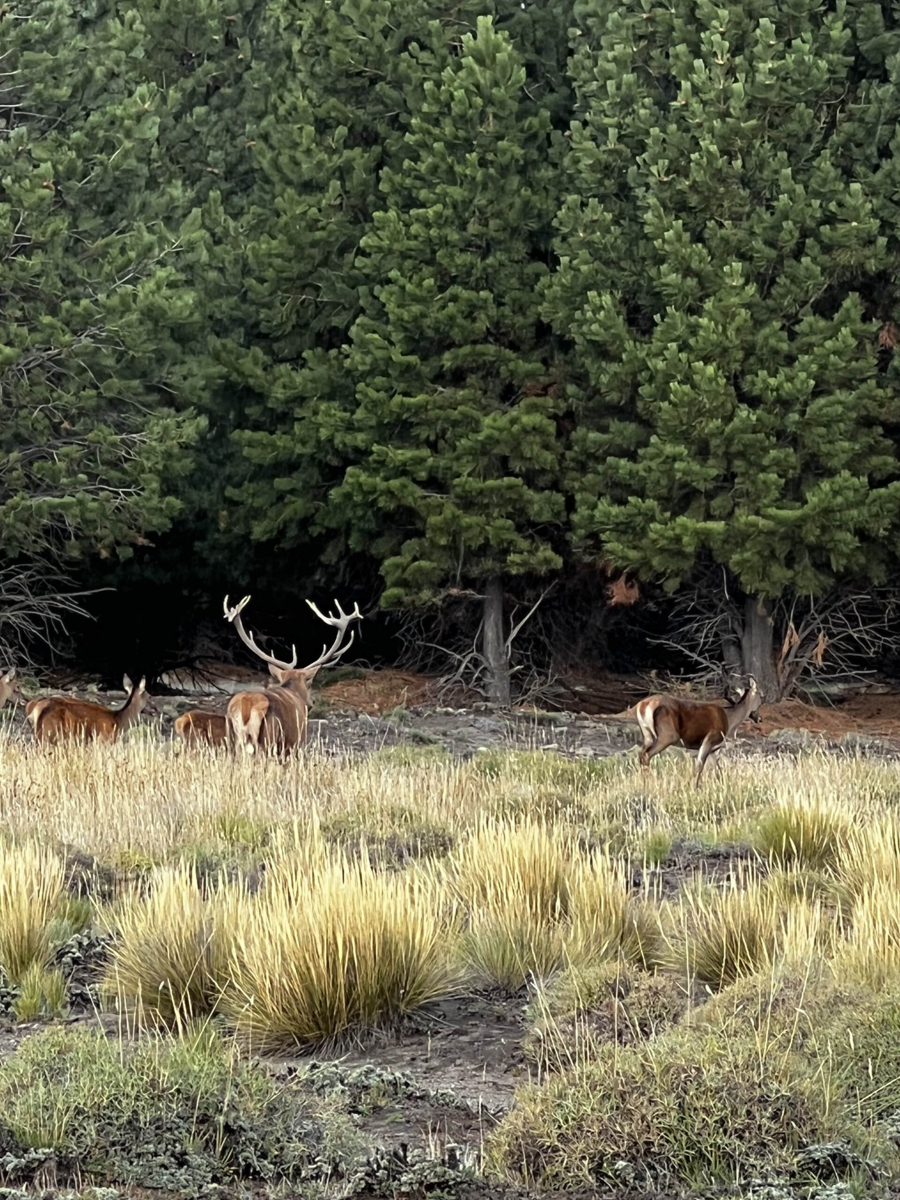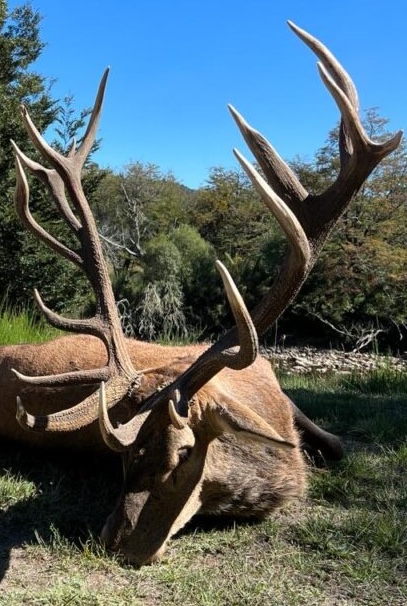Red Stag vs. Elk Hunting: A Rocky Mountain Hunter’s Guide to the Elk’s Long-Lost Cousin
Any avid sportsman and outdoors enthusiast who resides in the Rockies & Pacific Northwest is well acquainted with what an elk is. Their size, beauty, and popularity make it damn near impossible not to have at least heard of them.
Now, what these same folks may not have heard of is the red stag.
Elk and red stag share a lineage but differ in size, sound, and locale. Elk are heavier, with bulls averaging between 700 and 800 pounds, while red stag typically weigh in at around 400 to 500 pounds.
They also have their own, unique calls. Where elk bugle with a high-pitched whistle, red stag roar with a deep guttural bellow, and the differences between the two aren’t just limited to that:
| Feature | Elk (Rockies) | Red Stag (Argentina) |
| Average Weight | 700–800 lbs (bulls) | 400–500 lbs (stags) |
| Antler Style | Wide, symmetrical beams | Crowned tops, palmated ends |
| Vocalization | High-pitched bugle | Deep, guttural roar |
| Rut Season | September through October | March through April |
| Elevation Range | 6,000-11,000 ft | 1,000-4,000 ft |
| Habitat | Alpine basins, aspen groves | Caldén forest, foothill ridges |
| How to Hunt | Public land, tags, and draws | Private estancias and outfitters |
| Shot Distances | 150–400 yards common | 100–250 yads forest, 400 yads open |
While it seems like they are extremely different, there are quite a few similarities that stand out as well, which we will get into.
Biology and Physical Differences

Elk (Cervus canadensis) and red stag (Cervus elaphus) diverged long ago, and most biologists now treat them as completely separate species.
Both species are categorized as large-bodied deer, but elk carry significantly more mass. As we mentioned earlier, a mature Rocky Mountain bull commonly weighs 700 and 800 pounds, while the heaviest Argentina stag will rarely break 600.
That size gap matters in several ways, with elk typically being able to withstand a similarly-placed shot longer than a red stag.
Antler structure also separates the species. Elk are known for growing wide, sweeping beams with 6×6 frames common, while stags develop more compact racks that often culminate in crown-like tops.
For elk hunters used to scoring symmetry at a distance, stag antlers require far closer inspection to accurately judge maturity.
Quick points:
- Elk:
- 700–800 lbs, antlers 260–400+ B&C
- Crowned antlers, with palmated tops
- Red stag:
- 400–500 lbs, typical free-range antlers 250–300 SCI
- Antlers symmetrical with long beams
The Sound: Bugle vs Roar
The most obvious distinction between these two massive animals in the field is vocalization.
Elk bugle in high-pitched, whistle-like calls that carry for miles across open basins. This call is highly recognizable and at one time stuck fear into the hearts of European settlers. Now, hunters use these calls to triangulate a bull’s location from miles away.
Red stag, on the other hand, roar with a guttural bellow. This different type of call carries less distance, but its resonance through valleys and forests makes it no less useful for hunters considering the terrain.
For Rocky Mountain hunters, this means there will be a need for adjusting strategy.
Bugles allow long-range tracking and rather aggressive calling setups. Roars require more patience in close cover, so when a stag roars 200 yards away in thick forest, you may need to move faster than you thick, as it may be the only chance to close the gap before the harem moves.
At a glance:
- Bugle: High-pitched, whistle-like, long-range locator
- Roar: Deep, guttural, shorter-range but resonant in timber
Rut Timing

Rut windows are another key difference that makes these two types of deer so different.
Elk peak in mid-September through early October, coinciding with archery and bowhunting seasons across much of the Rockies, with rifle hunters often catching the tail end or post-rut hunts.
Red stag roar from late March through April, giving big game hunters a surprisingly promising window. This inverted calendar gives North American hunters an amazing opportunity to potentially chase elk in the Rockies in the fall, then tour down to go red stag hunting in Argentina during the late summer the following spring.
At a glance:
- Elk rut: September to October
- Red stag rut: March to April
Terrain and How the Hunt Feels
Rocky Mountain elk occupy steep, high-elevation country between 6,000 and 11,000 feet. Hunts for these beasts often involve long ascents, glassing from open ridges, and miles of hiking through mixed forests.
Red stag habitats are quite different:
- La Pampa: Caldén forests create a thick sort of cover where senderos (cut shooting lanes) are important. Shot opportunities are often 100 to 200 yards.
- Patagonia: More open foothills with ridgelines and valleys. Here, glassing feels familiar to elk hunters, but the elevation is far lower, typically 1,000 to 4,000 feet.
For the Rocky Mountain hunter, this means less vertical grind but more brush navigation in La Pampa, and more wind exposure in Patagonia.
Access: Public vs Private
Another, if not the biggest difference between hunting elk and red stag, lies in access models.
In the United States, elk hunting is built on a public-land framework. Millions of acres of national forest and BLM lands are open to hunters, but obtaining a tag requires a long game of navigating draws, preference points, and crowded over-the-counter units.
In Argentina, red stag hunting is largely a private endeavor. Estancias and hunting outfitters manage herds across thousands of acres, often free-range but within ranch boundaries.
This means less competition, but also fewer DIY opportunities, and opportunities in general. For a U.S. hunter, the difference is less about physical skill and more about the hunting culture and how to access and pay for such a desirable hunt.
Skills That Transfer
When it comes down to it, most of what makes a successful elk hunter applies directly to red stag:
- Glassing discipline
Understanding how glassing works and being willing to spend hours behind optics is critical.
- Wind reading
Where there are thermals in the Rockies, you have prevailing winds in Argentina.
- Shooting under fatigue
As you might imagine, both big game hunts require accuracy, even after long treks.
Where Adjustments For Hunting Are Needed

At the end of the day, every hunt does have its differences.
- Calling cadence – Bugles carry further than roars, so tracking and general setups change.
- Antler judging –Symmetry is easy when it comes to elk, red stag crowns require closer inspection.
- Harem dynamics –Stags may move harems differently in thick forests compared to open basins.
Gear Notes for Elk Hunters
Much of the elk hunting gear in a hunters kit carries over seamlessly to stag:
Hunting Boots – Supportive mountain boots are still a must-have, though thick brush punishes soles differently than scree fields.
Knives Let’s be honest, a compact, sturdy hunting knife for breaking down big game is needed on any hunt!
Layering – Just remember the time of year these seasons fall, so insulation and moisture control matter.
Firearms – The same cartridges generally work, with a .270, .30-06, 7mm Rem Mag, and .300 Win Mag all fitting the bill.
In short, an elk hunter does not need to reinvent their kit to hunt stag, just maybe a few minor adjustments.
FAQs
Are red stag and elk the same animal?
- No. Though related, they are classified as completely separate species.
Which is larger?
- Bull Elk are significantly heavier on average than red stag.
Is the roar like the bugle?
- No. The roar is deep and guttural and the bugle is higher pitched and whistle-like.
When does the stag rut happen?
- Late March through April, opposite of elk rut timing.
Do gear needs change?
- Not significantly. Elk hunting kits transfer directly to stag hunts.

